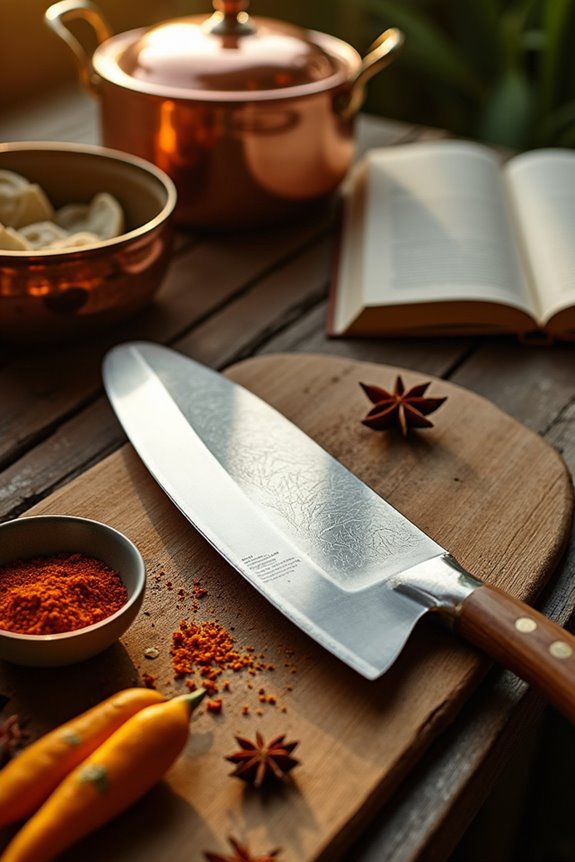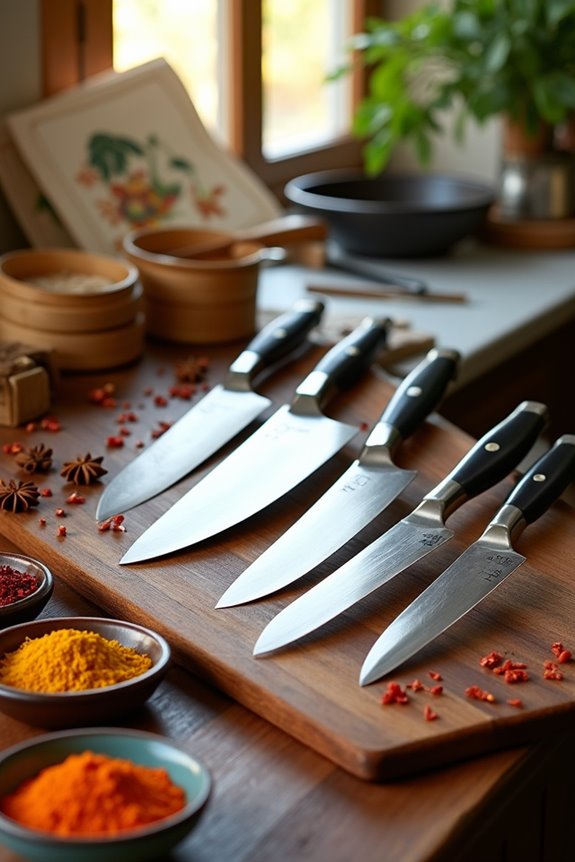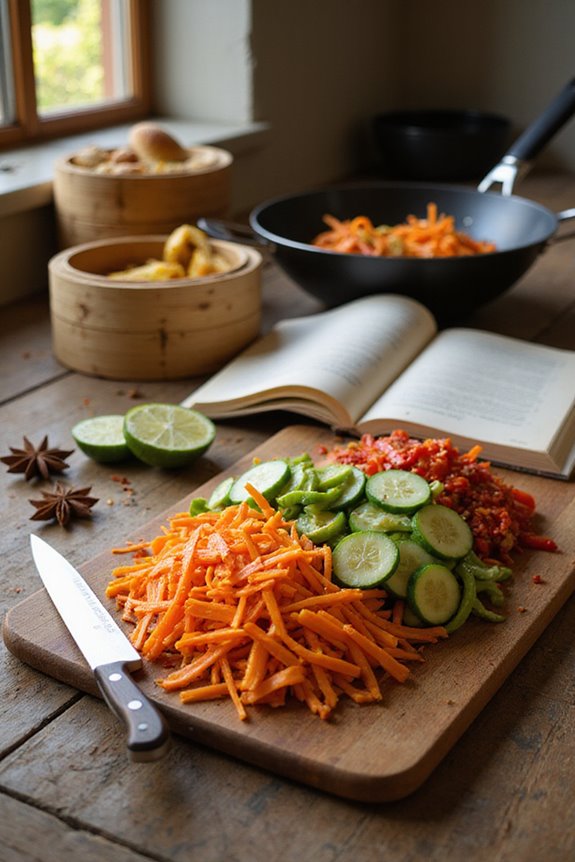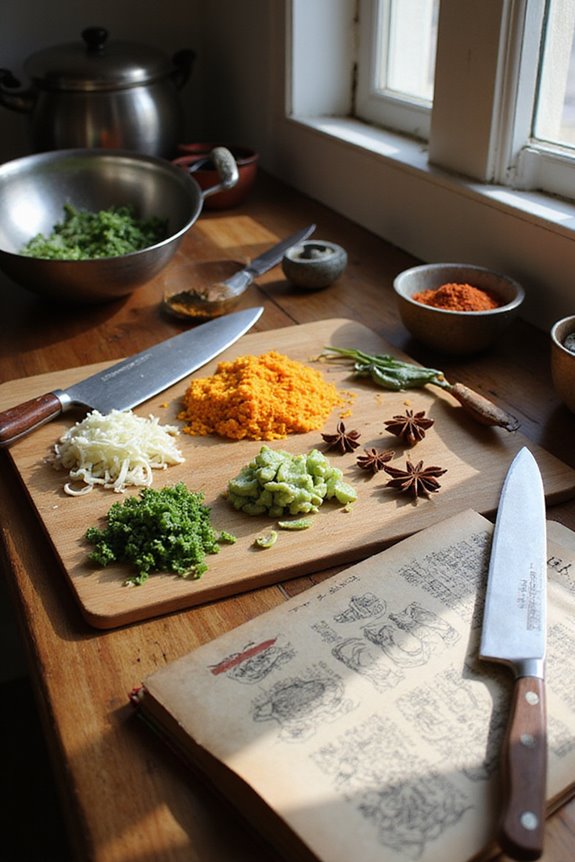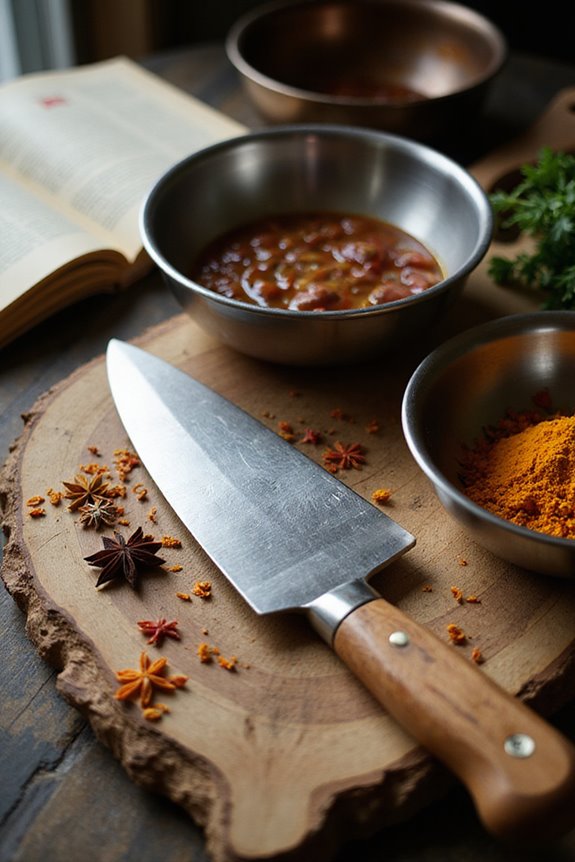To hold a cleaver like a pro, we’ve got some delightful tips for you! First, grip the handle close to the blade for better control. Use your thumb on one side and curl your fingers around—think of it as giving the cleaver a cozy hug! For tougher cuts, a full handle grip is magic. And remember, safety is key—keep your non-cutting hand curled to protect those fingers. If you’re keen for more tips, there’s plenty of chopping fun ahead!
Key Takeaways
- Grip the handle close to the blade for better control and precision during cuts.
- Use the thumb on the handle, adjacent to the blade, for enhanced balance and grip stability.
- Curl your fingers around the handle securely to prevent slippage while chopping.
- Maintain a relaxed wrist position behind the handle to reduce fatigue while using the cleaver.
- Adjust your grip based on the task, using a pinch grip for heavy cuts and an all-purpose grip for general chopping.
Understanding Cleaver Grip Techniques
When it comes to mastering the magical art of cleaver grip techniques, we’re all about creating a delightful experience in the kitchen! Understanding the basics helps us sharpen our skills. Let’s explore some essential cleaver techniques:
- Handle Position: Hold the cleaver handle close to the blade for better control.
- Thumb Placement: Rest your thumb on the handle, right next to the blade.
- Finger Placement: Curl your fingers over the handle for a secure grip.
- Grip Firmness: Keep that grip firm to prevent slippage—it’s like holding onto a holiday cookie!
These grip variations not only help us accomplish our tasks but also make cooking feel fun and engaging! Remember, proper handle ergonomics and comfort can greatly enhance your control, so grab that cleaver, and let’s make some kitchen magic together!
Different Types of Grip for Various Tasks
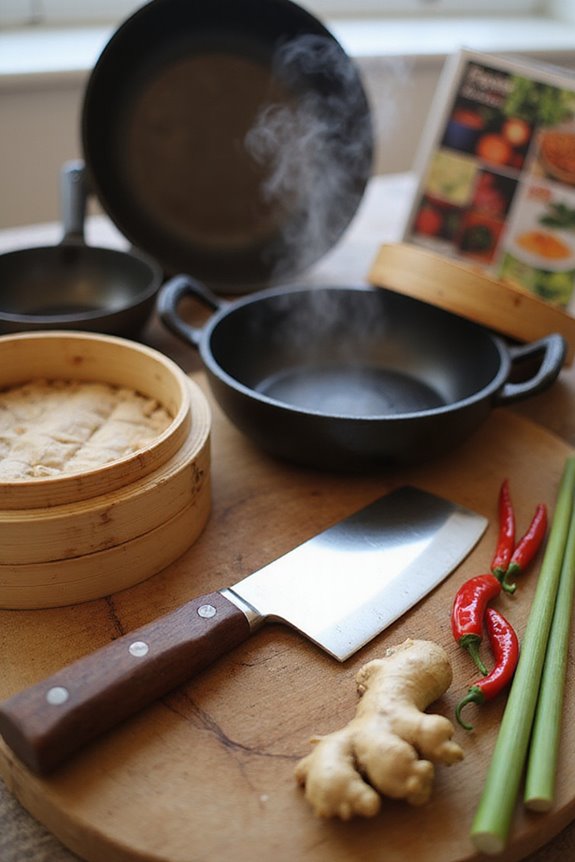
Mastering different grips for various tasks with a cleaver can feel like a culinary adventure! Let’s explore some exciting cleaver grip variations that make our cooking tasks effortless:
- All-Purpose/Power Grip: Perfect for general chopping. Hold near the blade’s base for control, letting us chop swiftly with less fatigue!
- Pinch Grip: For those heavy-duty cuts like bones, using our thumb and index finger on the blade gives us ultimate precision.
- Modified Pinch Grip: For delicate trimming, this grip near the blade tip allows precise control, making every cut delightful.
- Horizontal Grip: Crush those garlic cloves like it’s a holiday party!
Don’t forget to adjust grip pressure techniques based on ingredient toughness. With practice, we’ll all find our way to becoming cleaver wizards! Additionally, proper care and maintenance of our cleavers will ensure they stay sharp and effective for our cooking adventures.
Proper Hand Position and Alignment
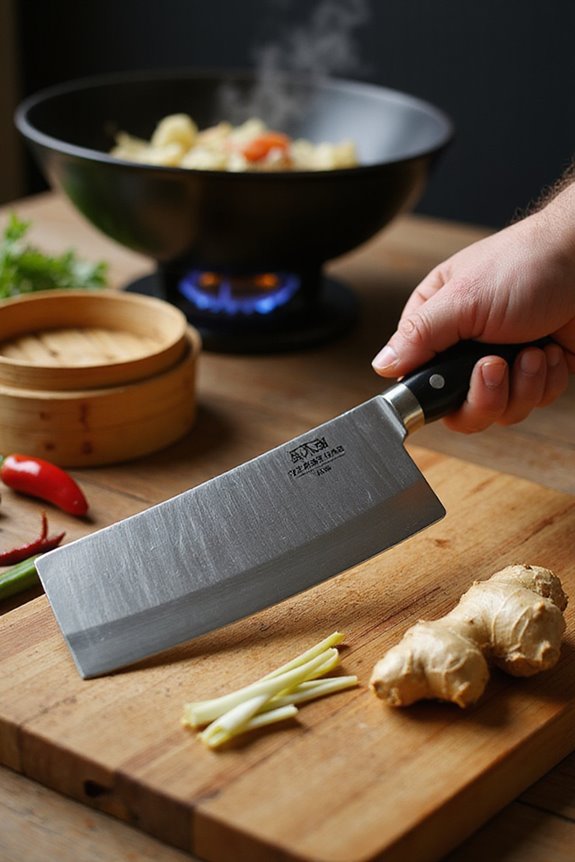
Proper hand position and alignment are essential for releasing the full potential of your cleaver, making each cut feel like a culinary dance!
Let’s explore hand positioning:
- Grip Near the Blade: Hold the handle close to the blade for better control.
- Thumb and Index Finger: Place your thumb on one side and your index finger on the opposite side for balance.
- Finger Curl: Curl your remaining fingers around the handle for a secure grip, like hugging a loved one during the holidays!
Wrist Alignment: Keep your wrist directly behind the handle—this helps with natural swings and power. A relaxed, yet firm wrist prevents fatigue, making our chopping experience magical. Additionally, employing a high carbon stainless steel cleaver allows for exceptional sharpness and durability, enhancing your culinary efforts.
With practice, we’ll chop like pros and feel confident in the kitchen!
Essential Cleaver Handling Motions
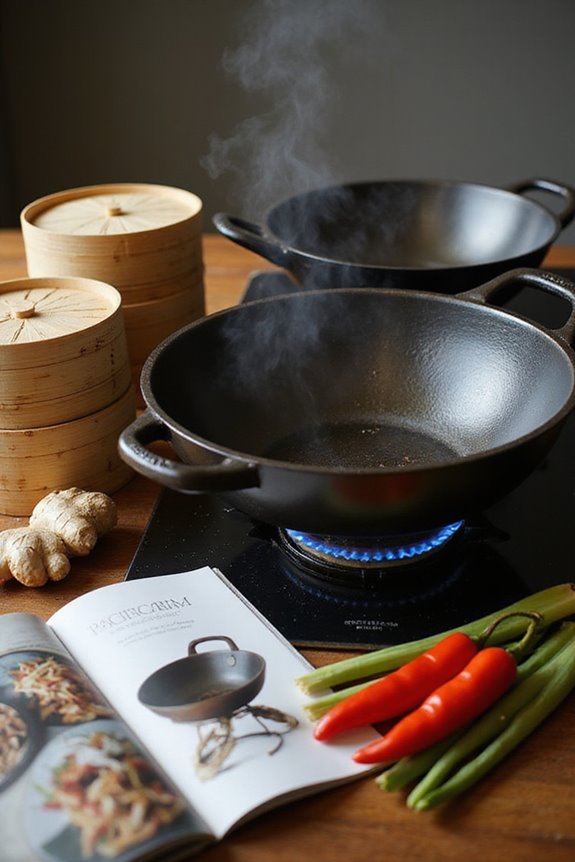
Now that we’ve got our hand position sorted, it’s time to plunge into the delightful world of essential cleaver handling motions.
Chopping and Slicing:
- Align the blade with your target for precise chops.
- Apply steady, controlled force to keep it safe and powerful.
- For smoother slicing, lift the cleaver between cuts and maintain a consistent angle.
Rocking and Crushing:
- Use the tip of the blade to mince herbs with a graceful rocking motion.
- For smashing garlic, press down with the flat side—skip the slipping! A sharp cleaver provides excellent heat conductivity which helps achieve better cooking results.
Safety Considerations and Ergonomics
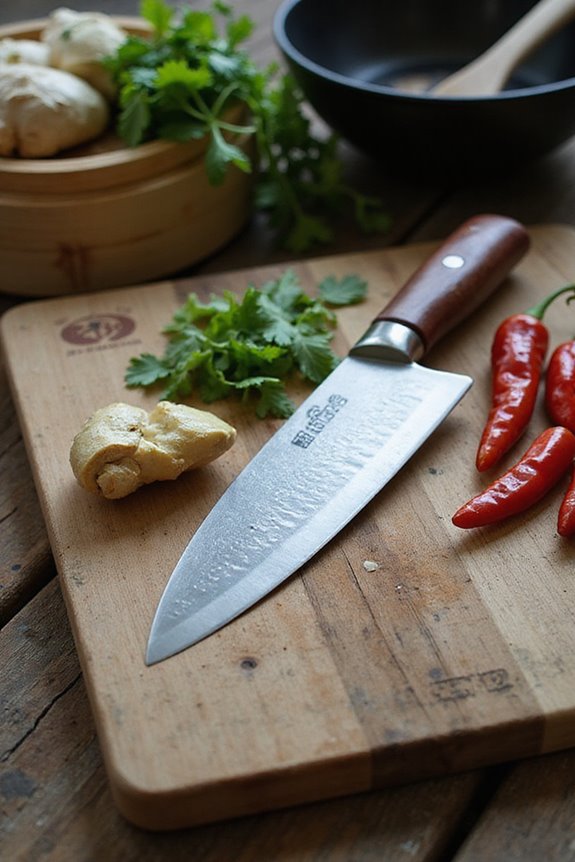
When we immerse ourselves in the magical world of cleaver handling, safety and ergonomics should always be top of mind. To enhance cleaver safety, let’s remember key grips: we can hold the cleaver close to the blade for precision or use a full handle grip for those tougher cuts. Keep our non-cutting hand curled like a claw to protect fingers.
For ergonomic benefits, we should choose a well-balanced cleaver. Positioning our body correctly makes chopping smoother and safer. Investing in high-quality materials ensures that our cleaver remains durable and effective for all our culinary adventures.
And just like we decorate a tree, let’s make sure our workspace is tidy and free from clutter—less mess means fewer accidents! Together, we’ll embrace every delightful chop and slice, enjoying our time in the kitchen!
Frequently Asked Questions
What Type of Cleaver Is Best for Home Cooking?
When choosing a cleaver for home cooking, we should consider cleaver types like the versatile Victorinox or SAKUTO. Opting for the best materials, like stainless or Damascus steel, guarantees durability and performance for all our culinary adventures.
How Can I Improve My Cleaver Skills Quickly?
To improve our cleaver skills quickly, we should practice essential cleaver techniques, focus on our chopping speed, and switch between tasks. With time, we’ll build confidence and precision, making us more adept in the kitchen.
Is Sharpening My Cleaver at Home Safe?
Indeed, dear reader, as we commence on sharpening our cleavers at home, let’s prioritize cleaver safety. By employing proper sharpening techniques, we can considerably reduce risks while honing our culinary finesse together.
How Do I Clean and Store a Cleaver Properly?
When it comes to cleaver maintenance, we’ve got to wash it right after use, and store it safely. Prioritizing kitchen hygiene guarantees our cleavers remain sharp, clean, and ready for our next culinary adventure together!
Can a Cleaver Be Used for Chopping Herbs?
Nearly 80% of chefs prefer smaller knives for herb chopping due to control issues. While we can explore cleaver techniques, they’re better suited for heavy tasks than the finesse needed for delicate herbs. Let’s stick with precision.

